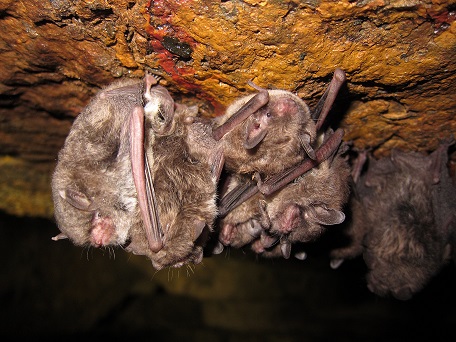Bats do not use the same bat cave all year round! They have different resting places, called roosts, that they utilize throughout the season depending on their needs.
Hibernaculum– A hibernaculum is where some species of bats hibernate through the winter. Hibernacula (plural of hibernaculum) are often caves, mines, or buildings. Eastern red bats may even use leaf litter, tree cavities, or forest foliage. These places maintain a steady temperature above freezing and high level of humidity throughout the winter, which minimizes the energy and water stores bats use while hibernating. The same hibernaculum can be used by multiple different species and can hold hundreds of thousands of bats each winter. Many bats return to the same hibernaculum each year which allows for researchers to monitor populations through winter bat counts.

Maternity Roost– Depending on the species, females will tend to roost together during summer while they are pregnant, giving birth, and caring for pups. Some species have maternity roosts of only a few members, while some species have maternity roosts of several thousand. One grey bat maternity roost has over 4,000 individuals in Illinois! Roosting in groups provides security and shared warmth among the mothers and helpless pups. Maternity roosts of threatened or endangered species are legally protected as the bats are especially vulnerable during this time in their life cycle. Also, typically bats will return year after year to the same locations because the microclimate of these roosts needs to be just right for the young to develop properly making these trees critically important. Maternity roosts can be in buildings, bat boxes, caves, or trees.
Day Roost– During the summer, male bats, non-reproductive females and species that do not create maternity colonies roost in many different types of places during the day, including buildings, bridges, caves, rock formations, tree bark, tree cavities, bat boxes, leaf litter, and other types of foliage. Many factors of day roosts are species specific. Some species roost together in thousands, while some species roost individually or in small groups. Some individuals utilize the same roost throughout the season, while others change their roosts often. Bats even change roosts to socialize with other bats. Temperature is again an important factor in day roosts. Roosts can often heat up under the sun, which can cause bats to die of heat exposure.

Night Roost– Bats often will take a break and roost while they feed during the night. They may rest, digest, conserve energy, and avoid predators especially if they are young and just learning to fly. The length and time of night roosts varies individually and seasonally. Night roosts often tend to be less sheltered than other roost types, as bats roost there for only a few hours. This may be when you see them by your porch light or under your gazebo.

